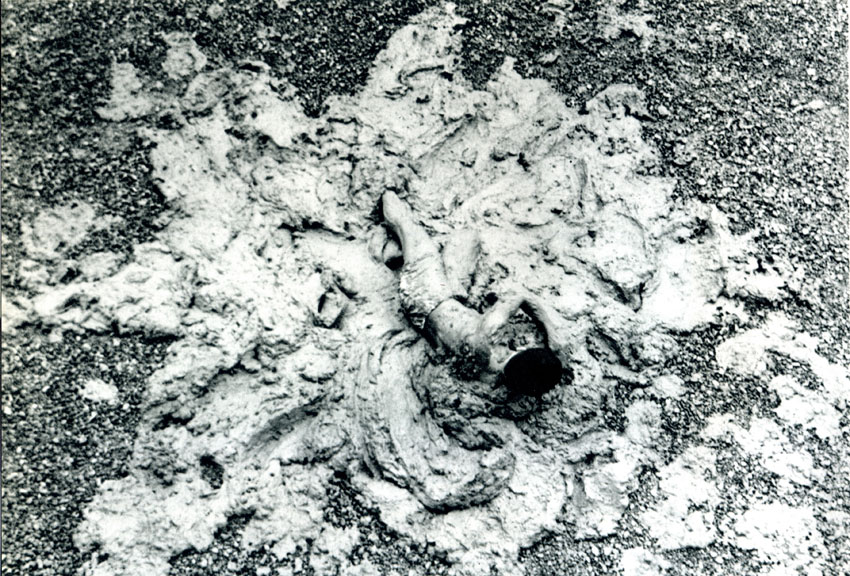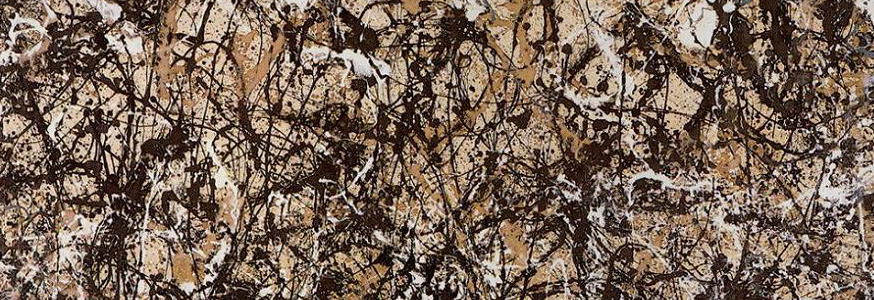I reckon writing for a blog can be a little less formal and hopefully a little more provocative than writing in an academic context or for a ‘proper’ publication. So I start this post with a provocation Jackson Pollock wasn’t abstract or expressionist.
As far as provocations go it isn’t that radical. Artists and critics have been re-imagining the significance of Pollock’s work since he first came to prominence. In 1969 Joseph Kosuth argued persuasively that Pollock’s real innovation was a propositional one:
If Pollock is important it is because he painted on loose canvas horizontally to the floor. What isn’t important is that he later put those drippings over stretchers and hung them parallel to the wall. (In other words what is important in art is what one brings to it, not one’s adoption of what was previously existing.)
To reiterate; what Pollock brought to art was painting on loose canvas on the floor and, in Kosuth’s propositional terms, what he was effectively saying by doing that is “art can also be made in this loose floor-to-body configuration of matter” (a new proposition). Kosuth also makes an important point in relation to the idea of expression in Pollock’s work:
What is even less important to art is Pollock’s notions of “self-expression” because those kinds of subjective meanings are useless to anyone other than those involved with him personally. And their “specific” quality puts them outside of art’s context.
This is an important point and it was partly this kind of thinking that led to range of post-expressive art propositions in the 1960s including those associated with minimalism, op-art, video art, algorithmic art, the light and space movement and conceptual art. More specifically, in relation to Pollock’s work, Kosuth is pointing out that the idea of “self-expression” is pretty useless when it comes to the task of understanding what Pollock was doing.
We’ve also seen how the cold-war propaganda machine held up Pollock, and abstract expressionism more generally, as an example of freedom, individualistic expression and U.S. cultural power. This connection to cold war propaganda makes notions of self-expression even more dubious in relation to Pollock’s work. So Pollock wasn’t an expressionist, at least in the narrow sense of self-expression.
What about abstraction? Surely Pollock’s canvasses are abstract, right? Well, no. I reckon this is another idea that gets in the way of understanding what Pollock was doing. His paintings are not abstracted from anything representational and they are more immediately concerned with the concrete material presence of the paint and its properties than they are with a more general notion of abstraction (a notion of the term that isn’t defined in relation to representation). In fact Pollock himself may have acknowledged this if what seems like an apocryphal story is actually true. Apparently Hans Hoffman asked Pollock if he worked from nature to which his response was “I am nature”. The implication is that his work wasn’t abstract but rather the concrete embodiment of certain energies.
The concrete material aspect of Pollock’s work is something that his contemporaries also commented on. Amongst the artists who best understood what Pollock was up to were the Gutai group from Japan. Written in the year that Pollock died Jiro Yoshihara’s “Gutai Manifesto” (1956) was a prescient document in many ways, not least because it appeared decades before theorists and artists associated with New Materialism started to flesh out similar ideas. In the manifesto Yoshihara writes; “If one leaves the material as it is, presenting it just as material then it starts to tell us something and speaks with a mighty voice.” Later in the same document he writes:
I pay respect to Pollock’s and Mathieu’s works in contemporary art. These works are the loud outcry of the material, the very oil or enamel paints themselves. The two artists grapple with the material in a way which is completely appropriate to it and which they have discovered due to their talents. This even gives the impression that they serve the material. Differentiation and integration create mysterious effects.
It makes me smile thinking about whether the CIA would have picked up Pollock’s work if he had said that he was simply serving his materials (a notion far less in tune with individualist capitalist ideology) rather than expressing himself. But there is a serious side to this too. I also wonder whether Pollock may have contributed a lot more to the history of art if he wasn’t burdened by the rather unproductive idea of self expression. The Gutai materialist philosophy, on the other hand, has been incredibly productive for many artists. For example Kuzuo Shiraga, born only twelve years after Pollock and who was responsible for one of the iconic Gutai works, Making a Work of Art with My Body, (1955) was still making interesting work six decades later.
 Kazuo Shiraga, Making a Work of Art with My Body, 1955, mud, plaster and the artist.
Kazuo Shiraga, Making a Work of Art with My Body, 1955, mud, plaster and the artist.
Pollock appears to have known about Shiraga’s work with books by the Japanese artist found in Pollock’s studio. One wonders what may have happened if the connection between Pollock and Shiraga had grown. Perhaps if Pollock had taken up a Gutai-materialist focus he wouldn’t have entered the cycle of disillusion and alcoholism that led to his death. But this is pure speculation and a bit of a distraction from the current question of how to describe Pollock’s work.
Jackson Pollock was a visceral materialist
On one level Pollock’s engagement with materiality is obvious. His drips are a concrete manifestation of the viscosity of the paint in relation to the dynamics of the body and its extension through brushes and sticks. I can readily imagine a bio-mechanical, fluid dynamics analysis of Pollock’s work (perhaps complimentary to studies that have looked at the work’s fractal dimensions). I reckon you could find some interesting correlations between the viscosity of the paint and the forms in Pollock’s more refined works.
Regardless of whether you look at Pollock’s work from the point of view of fluid dynamics or not its possible to make the argument that it was more a case of the paint expressing itself through Pollock than it was Pollock bending the material to his own expressive ends (or in Gutai terms he was at the service of the material). In other words the material properties of the paint suggested certain forms and that is why we can think of Pollock in materialist terms. This becomes a visceral materialism in the case of Pollock because his practice represents a determined effort to feel what the material can do and that effort to feel is registered as a record of action in the work itself. It is as if Pollock was able to imagine that the paint dripped directly from his veins. That is the viscera of Pollock’s work. The paint becomes continuous with his body and the expressive dimension is in the effort to think through the corporeal-material assemblage, to work out what it can do. This is a process we can sense in a work like Autumn Rhythm (number 30) a detail of which you can see at the top of this post. As Kosuth points out subjective “self expression” is irrelevant to this argument, but there is a secondary expressive dimension (the paint expressing itself through Pollock) that emerges from the visceral materialists aspects of Pollock’s practice.
While I agree with Kosuth when he says that Pollock’s importance has to do with him painting on ‘loose canvas horizontally to the floor’ I think we need to add to that formulation. Part of Pollock’s importance is in the fact that he took industrially produced alkyd enamel paint and came to such a visceral understanding of what it could do in a human-material assemblage. And not only that, we as viewers we can appreciate the material expression and thought that is present in the canvasses. Its worth emphasising that its not the novelty of the use of house paint that is the strength of Pollock’s work (although it was a relatively new material) but rather the depth of material thought that is in evidence across the complete body of work that he produced with that paint; deep thinking with materials matters, new materials just for the sake of their newness is of no real significance.
Image top (detail): Jackson Pollock, Autumn Rhythm (number 30), 1950, Enamel on canvas, 266.7 x 525.8 cm.
